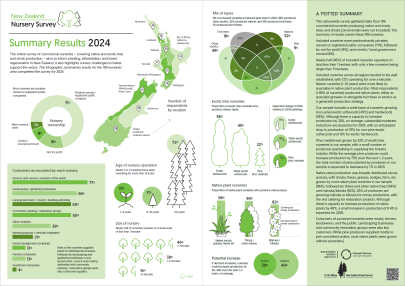2024 Nursery Survey
 This online survey of commercial nurseries – covering native and exotic tree and shrub production – aims to inform planting, afforestation, and forest regeneration in New Zealand. It also highlights nursery challenges to better support the sector.
This online survey of commercial nurseries – covering native and exotic tree and shrub production – aims to inform planting, afforestation, and forest regeneration in New Zealand. It also highlights nursery challenges to better support the sector.
This infographic summarises results for the 199 nurseries who completed the survey for 2024.
Overview: A 'potted' summary
This nationwide survey gathered data from 199 commercial nurseries producing native and exotic trees and shrubs (ornamentals were not included). This summary of results covers these 199 nurseries.
Included nurseries were predominantly privately owned or registered public companies (71%), followed by not-for-profit (16%), and central / local government owned (8%).
Nearly half (46%) of included nurseries operated on land less than 1 hectare, with only a few nurseries being larger than 5 hectares.
Included nurseries across all regions tended to be well established, with 72% operating for over a decade. Newer nurseries (1–10 years) were more likely to specialise in native plant production. Most respondents (>90% of nurseries) produced native plants, either as specialist growers or alongside fruit trees or exotics as a generalist production strategy.
Our sample includes a wide base of nurseries growing (non-pine) exotic softwoods (45%) and hardwoods (56%). Although there is capacity to increase production by 30%, on average, substantial/moderate reductions are expected for 2025, with an anticipated drop in production of 33% for non-pine exotic softwoods and 13% for exotic hardwoods.
Pinus radiata was grown by 22% of exotic tree nurseries in our sample, with a small number of producers specialising in supplying the forestry industry. While the average pine producer could increase production by 75% over the next 1–2 years, the total number of pines planted by producers in our sample is expected to decrease by 7% in 2025.
Native plant production was broadly distributed across species, with shrubs, flaxes, grasses, sedges, ferns, etc. grown by most native plant nurseries in our sample (96%), followed by totara and other native trees (94%) and manuka/kanuka (82%). 25% of producers are growing manuka or kanuka for honey production, with the rest catering for restoration projects. Although there is capacity to increase production of native plants by 40%, a small increase in production of 0.4% is expected for 2025.
Customers of surveyed nurseries were mostly farmers, landowners, and the public. Landscaping businesses and community restoration groups were also key customers. While pine producers supplied mostly to pre-committed orders, most native plants were grown without preorders.












